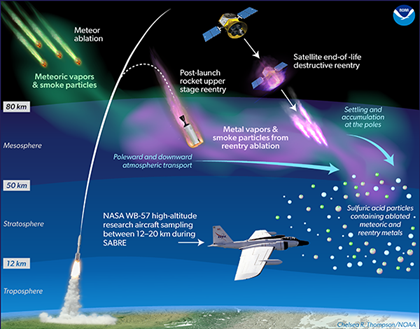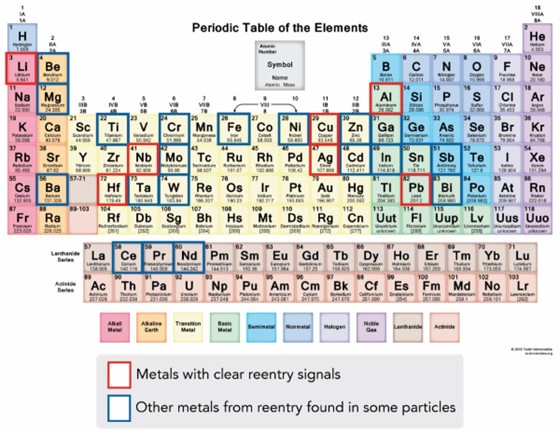What goes up must come down
A satellite or rocket launch has always elicited reactions of awe and wonder. Even with the increasing number of launches, that sense of awe will probably never diminish. But now that the satellite numbers are rapidly increasing, so is the awareness that the more-frequent launches, along with the eventual satellite debris that burns up as it descends back toward Earth, are affecting our atmosphere.
A new study published last fall in the Proceedings of the National Academy of Sciences looked at the most common type of particles in the stratosphere, using an ultra-sensitive instrument aboard a high-altitude research aircraft to “fingerprint” the particles’ chemical composition.

Graphics credit (above and below): Chelsea R. Thompson, NOAA Chemical Sciences Laboratory.
The researchers found that an astonishing number of particles had tell-tale signs of satellite debris. About 10% of the stratospheric sulfuric acid particles contained aluminum and exotic metals, in ratios consistent with the composition of satellite materials. For example, they detected niobium and hafnium, which are used in making semiconductors and alloys and have no other sources in the stratosphere.
The study is the first to definitively link stratospheric pollution to satellite debris. The stratosphere’s ozone layer is our planet’s “sunglasses,” protecting Earth’s surface from harmful levels of ultraviolet radiation. It is not yet known how the perturbations from satellite debris might affect the ozone layer or climate.

The PNAS study is intriguing and not altogether surprising, as the number of satellite launches has (literally!) skyrocketed over the last decade. Nearly 9000 satellites are currently in orbit, and most will burn up upon reentry. Over 5000 satellites were launched just within the last 5 years.
Based on filings for radio frequencies (needed in advance of launches), the number of satellites could reach 1 million. For example, one filing request is for over 330,000 satellites, which would dwarf the current 4500-satellite Starlink constellation of Space-X. In such future scenarios, the middle atmosphere could become a much busier place–and the new frontier for studies of atmospheric pollution.
Metals from spacecraft reentry in stratospheric aerosol particles, Murphy, D.M., M. Abou-Ghanem, D.J. Cziczo, K.D. Froyd, J. Jacquot, M.J. Lawler, C. Maloney, J.M.C. Plane, M.N. Ross, G.P. Schill, and X. Shen, Proceedings of the National Academy of Sciences, doi:10.1073/pnas.2313374120, 2023.
